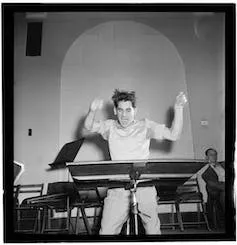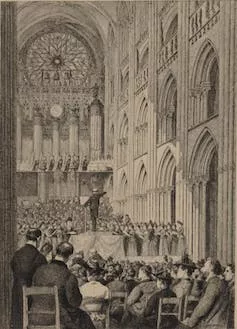
In recent years there have been many films about orchestra conductors. At the beginning of this year we had Tar, based on the conductor Marin Alsop. Also premiering soon are Divertimento, a film about the creation of an orchestra of the same name by conductor Zahia Ziouani, and Maestro, a biopic of the charismatic Leonard Bernstein.

In films such as these, you can sense the halo of mystery that surrounds the figure of the conductor, which composer and music critic Robert Schumann called “a necessary evil” as early as 1836.
To the untrained eye, the conductor stands on a podium and wildly gesticulates in front of a group of musicians who already have an intimate knowledge of the scores they are performing. The conductor is the only member of an orchestra who has no instrument, and makes no sound of their own throughout the performance. This begs the question: what contribution does a conductor make to the quality of an orchestra’s sound?
We will focus here on their two basic functions: technical and expressive leadership.
Keeping time
If we closely watch the conductor’s movements during a concert, we will soon notice one of these roles, which is keeping the piece in time.
The earliest references to the need for musical timekeeping in western culture can be found in treatises on music from the 16th century, when musicians were recommended to guide themselves by tapping their hands or feet. However, the first symphonic orchestral ensembles during the 18th century – the era of musical classicism that we associate with composers such as Haydn or Mozart – still had three characteristics that made the existence of a conductor unnecessary.
Firstly, the number of musicians in ensembles was small, which made them easier to coordinate. Secondly, rhythm generally stayed the same across most compositions, making it easier to maintain without an external guide. Lastly, musicians played almost continuously from the beginning to the end of a piece. It was often the composers themselves, playing a harpsichord or violin, who guided the simple beginning and end of a piece.

The first third of the 19th century, when Beethoven (1770-1827) was making his mark on Western culture, was when the need for orchestral conductors emerged. His work represented a quantum leap in terms of the complexity of compositions. The size of orchestras increased substantially, and instruments began to vary their roles in more sophisticated orchestrations.
These developments meant that formal rehearsals had to be organised prior to performances, often led by composers themselves. Considering that a symphony orchestra has a minimum of eighty members, it is easy to understand the need for a leader to synchronise the musicians’ entrances, as well as the rhythm and tempo of a piece. While the musicians have only their respective parts written in front of them, the conductor looks at the complete score, and is therefore the only person with an overall vision of the piece being played.
Unique style
The ability to perform a composer’s work without their presence, which came about as a result of an international market of music publishers, leads us to the second basic function of a conductor: expressive and artistic leadership.
The gradually developing field of musical notation allowed composers to communicate specific instructions about the character and performance of their pieces. However, notation does not even come close to comprehensively conveying a piece’s intended impact. This means that the same piece can have an infinite range of interpretations, and this where orchestral conducting becomes extremely important.
The score annotations of composer and conductor Gustav Mahler offer a good example of this openness. He noted in a passage of his Second Symphony that “trombones, violins and violas should play only if necessary to prevent the chorus from deflating”, leaving the final decision up to the conductor. Other indications of his, such as “with maximum power” or “imperceptible, a little more agitated” give an idea of the multiple potential readings of a piece’s character.
With such a margin of interpretative freedom, the conductor is free to create their own mental model of how a piece should be performed, resulting in personal versions that can be very different. These differences can be clearly seen if we compare the opening bars of Karajan’s, Fürtwangler’s or Savall’s respective versions of Beethoven’s Coriolan Overture. https://www.youtube.com/embed/t-gROZkUAMY?wmode=transparent&start=0 The Coriolanus Overture conducted by Karajan with the Berliner Philharmoniker in January 1975.
The group leader
The next step for the conductor is to persuade a group of tens, perhaps even hundreds, of musicians to coordinate their individual performances with the same expressive intent.
This task requires considerable leadership, as it involves making an ensemble follow the conductor’s interpretation and instruction. It not only encompasses tempo, but also the relative volume of each soloist or instrumental group, the phrasing, and conveying the nuances that will colour the piece’s overall effect.
As in so many other fields of activity, such leadership has historically been exercised through hierarchical power structures and authoritarian attitudes. There are therefore many anecdotes of such conductors: the hot tempered Toscanini who frequently insulted the orchestra; the capricious von Karajan who conducted with his eyes closed and hardly spoke to the musicians; and Claudio Abbado, who was gentle and polite in his manner but was known for whispering the names of musicians he wanted out of his concerts to his artistic director at the end of rehearsals.
Nowadays, musicians have more of a voice in institutions. There is also greater diversity in orchestras, a fact which demands a closer, more open and more persuasive form of leadership.
Venezuelan conductor Gustavo Dudamel, who will soon conduct the New York Philharmonic, Kirill Petrenko, who helms the Berlin Philharmonic, and the very young Klaus Makkela, recently appointed chief conductor of the Dutch Royal Concertgebouw, are great examples of conductors who add value and make an impact. They are able to create an environment in which the orchestra’s musicians feel stimulated, can grow artistically, and are motivated to perform music at the highest possible standards.
Cristina Simón, Master en Musicología por la Universidad de La Rioja y Profesora de Comportamiento Organizacional en IE University, IE University
This article is republished from The Conversation under a Creative Commons license. Read the original article.
Stay updated with all the insights.
Navigate news, 1 email day.
Subscribe to Qrius
